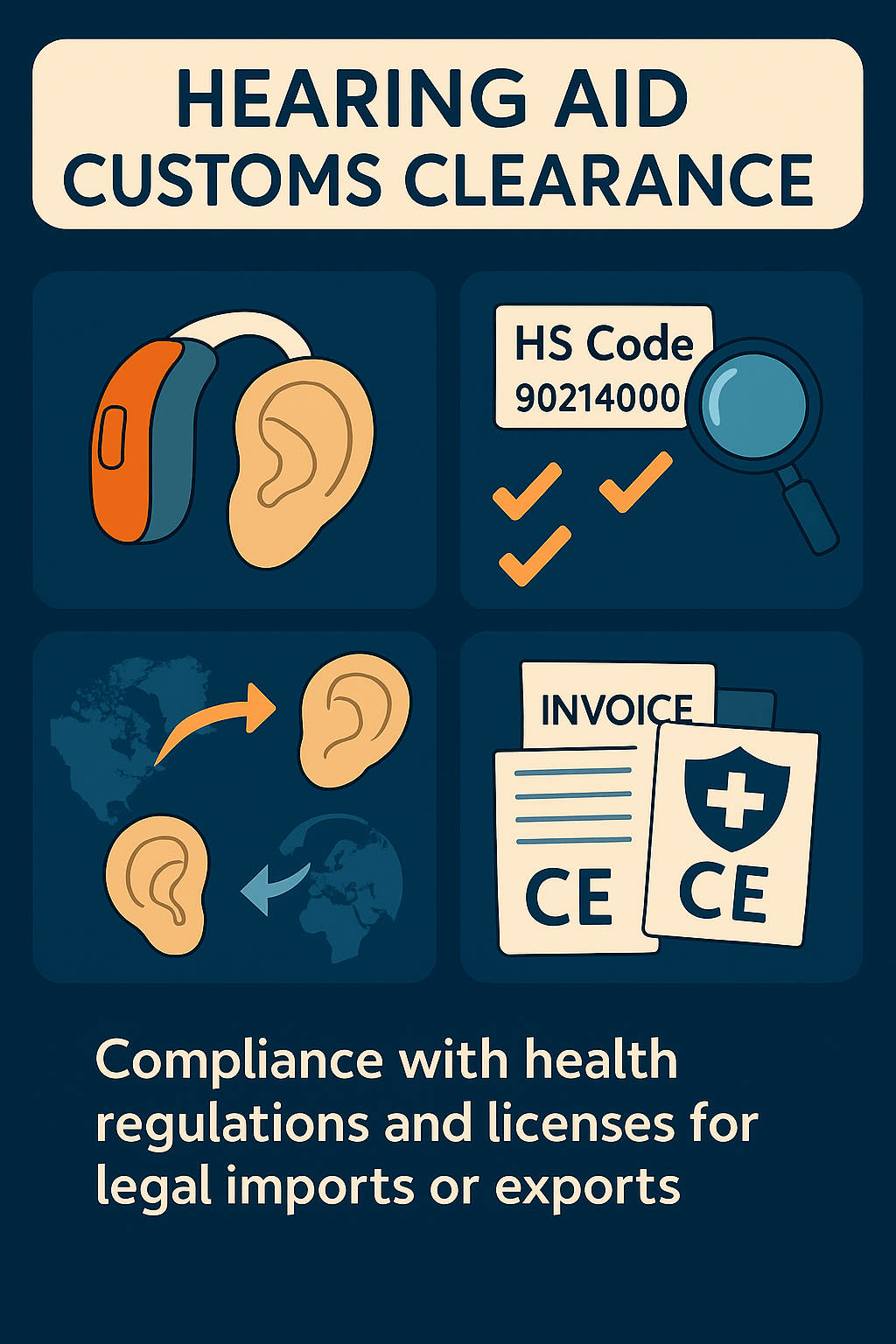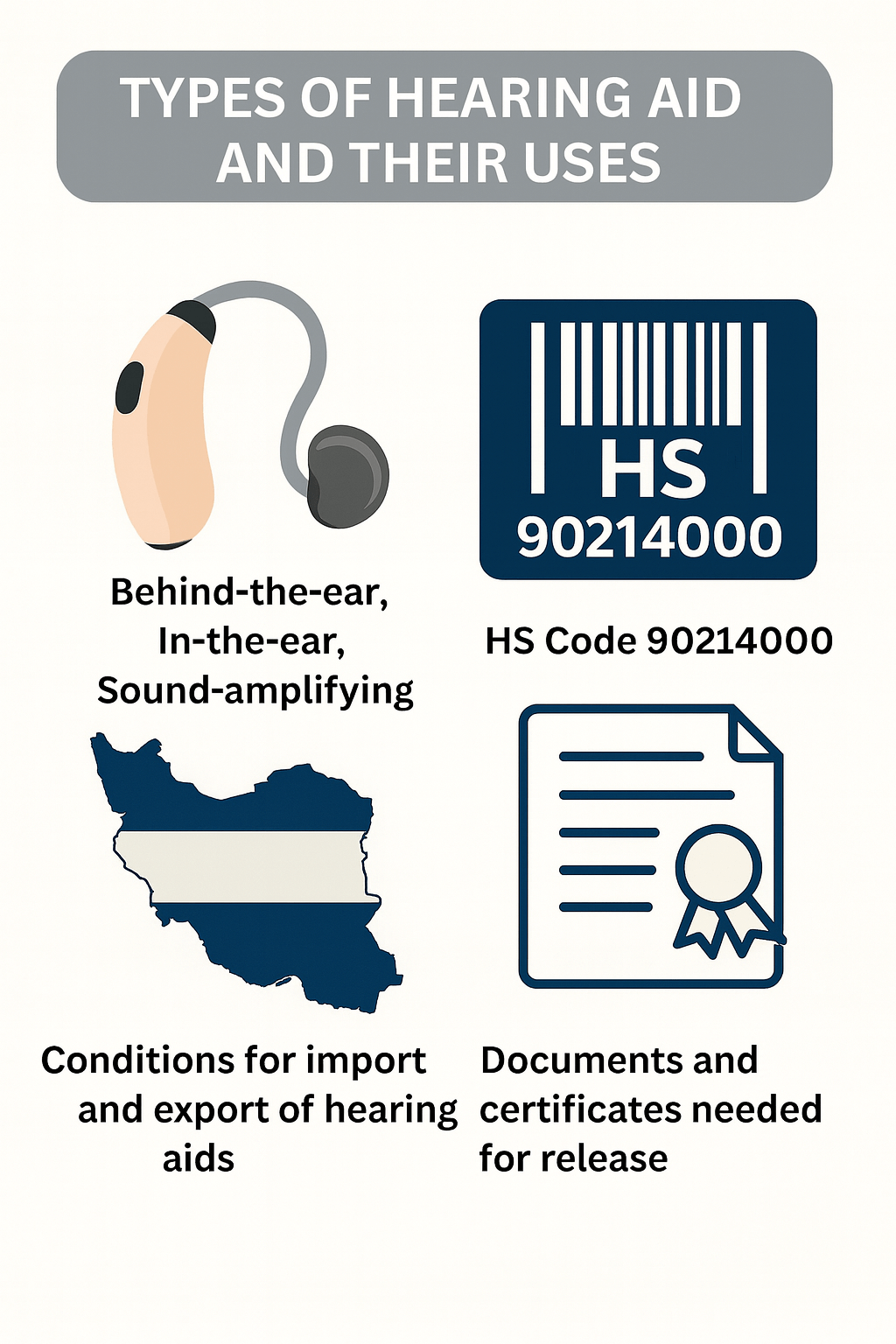Hearing Aids Customs Clearance in Iran (HS Code + Documents & Permits)

For accurate estimates of the time and cost to clear hearing aids and to coordinate Ministry of Health permits, contact the Saba Tarkhis experts.
Immediate & Free Consultation1) Types of Hearing Aids & Their Uses
2) Hearing Aids Customs Clearance Process
3) Import & Export Conditions in Iran
4) Special Conditions for Import & Export
5) Required Documents for Hearing Aids Clearance
1. Proforma Invoice:
As the preliminary quotation, it includes full device specs, price, payment terms, shipping terms, and seller/buyer details. Used for order registration with the Ministry of Industry, Mine & Trade (MIMT).
2. Commercial Invoice:
The final invoice with exact device specifications, quantity, unit/total price, payment terms, and seller/buyer details. Crucial for clearance.
3. Certificate of Origin:
Issued by the Chamber of Commerce or a competent authority in the country of origin; required for tariff determination and compliance.
4. Order Registration Form:
Issued by MIMT indicating the import is officially authorized; prepared before import and includes item specs, value, and other details.
5. Ministry of Health (FDA Iran) Clearance Permit:
Since hearing aids are medical devices, permits from the Ministry of Health/Food & Drug Administration (IMED) are required; includes necessary approvals and quality checks.
6. International Conformity Certificates:
Devices should have CE Mark and/or FDA clearance, evidencing compliance with international health and safety standards.
7. Transport Insurance Policy:
Covers risks during transit; must include insurance conditions, transport mode, and insured value.
8. Packing List:
Details of packaging: number of packages, net/gross weight, dimensions, and contents used for customs checks and document matching.
9. Customs Declaration:
Provides complete information on goods, value, tariffs, freight costs, and related details; submitted by the importer or customs broker.
10. Special Permits (if applicable):
Required when importing from sanctioned countries or where special authorizations apply.
11. Bill of Lading:
Indicates the shipment from origin to destination and includes carrier, consignor/consignee, and cargo details necessary for clearance.
12. Pre-Shipment Inspection (if required):
In some cases, goods must be inspected before dispatch by an accredited inspection company to confirm contractual compliance.
Preparing all documents accurately speeds up hearing aid clearance. With hands-on experience in medical and healthcare products, Saba Brokerage can help compile these documents and manage a professional, hassle-free clearance process.
| Item | Short Description | HS Code |
|---|---|---|
| Hearing aid (Analog/Digital) | Assistive medical hearing device | 90214000 |
Final classification depends on model (BTE/ITE/CIC), features, power source, and accessories.
Need precise HS coding, Ministry of Health permits, and document preparation? Our team manages your case end-to-end.
Request a Proforma Quote6) Key Tips & Practical Recommendations
- Ensure technical pre-alignment with the General Office of Medical Equipment (IMED); brand/model must be on the approved list.
- For large consignments, apply medical labeling standards (serial number, mfg/expiry dates, storage conditions) on carton/unit.
- Define warranty/after-sales terms and supply of consumables/batteries in the purchase contract.
- For high-traffic points (Tehran, Bandar Abbas, Bazargan), use a shorter clearance path with complete paperwork and coordinated shipping.
7) Best Practices for Hearing Aids Clearance in Iran
Fully prepare the file (order registration, IMED permit, CE/FDA, CO, CI, PL), coordinate transport (air/express for urgency), choose a medical-equipment specialist broker, pay duties/VAT on time, and perform quality control at entry points.

Frequently Asked Questions
What is the HS Code for hearing aids?
Hearing aids are generally classified under 90214000; final classification depends on model features and accessories.
What permits are required for import?
As applicable: Ministry of Health/FDA Iran (IMED) permit, MIMT order registration, and CE/FDA certificates, plus CO, invoice, packing list, and B/L.
What are the cost and timeline for clearance?
They depend on shipment size, transport route, completeness of documents, and the entry airport/customs. With a complete file, faster clearance is possible (especially at specialized medical-equipment customs).
Is import from sanctioned countries possible?
If sanctions apply, you’ll need special permits and strict compliance. Carefully review origin, banking, and shipping documents.
Saba’s Specialized Brokerage Services for Hearing Aids Clearance
With years of experience and a skilled team in medical and healthcare product clearance, we provide comprehensive, specialized services for hearing aids clearance from customs. Services include:
Pre-clearance consulting: Experts fully versed in customs, legal, and health requirements advise on proper HS classification, document preparation, and process optimization.
Obtaining required permits & documents: Through close coordination with the relevant bodies, all necessary documents and permits are secured quickly and accurately to accelerate clearance and reduce delay costs.
Fast & optimized clearance: Leveraging experience and expertise, hearing aids are cleared swiftly and efficiently so your goods reach the market without delay and at minimal cost.
Sanctions compliance & special import conditions: If importing from sanctioned origins, we handle required special permits and ensure full legal compliance.
Transparent, periodic reporting: You’ll receive clear status reports on clearance progress, enabling timely planning.
These specialized services ensure a smooth, expedited process so you can confidently bring your products to market.
.png)
